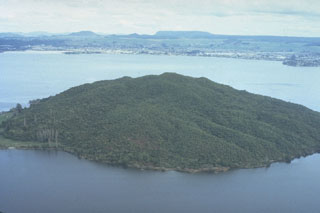Report on Rotorua (New Zealand) — December 2003
Bulletin of the Global Volcanism Network, vol. 28, no. 12 (December 2003)
Managing Editor: Richard Wunderman.
Rotorua (New Zealand) Two hydrothermal blasts on 6 November send solid material 14 m high
Please cite this report as:
Global Volcanism Program, 2003. Report on Rotorua (New Zealand) (Wunderman, R., ed.). Bulletin of the Global Volcanism Network, 28:12. Smithsonian Institution. https://doi.org/10.5479/si.GVP.BGVN200312-241816
Rotorua
New Zealand
38.08°S, 176.27°E; summit elev. 757 m
All times are local (unless otherwise noted)
Reported hydrothermal activity at Rotorua on 26 January 2001 involved the ejection of mud and ballistic blocks (BGVN 26:03). The New Zealand Institute of Geological and Nuclear Sciences reported that two subsequent hydrothermal eruptions in Rotorua caldera at Kuirau Park on 6 November 2003 blasted mud, rock, and ash 14 m into the air. Gray mud and small rocks littered a zone ~ 20 m wide and the eruption destroyed trees around the crater where it vented. The eruptions occurred just meters from the site of the large blowout in 2001. The area is known for this kind of geothermal activity.
Geological Summary. The 22-km-wide Rotorua caldera is the NW-most caldera of the Taupo volcanic zone. It is the only single-event caldera in the Taupo Volcanic Zone and was formed about 220,000 years ago following eruption of the more than 340 km3 rhyolitic Mamaku Ignimbrite. Although caldera collapse occurred in a single event, the process was complex and involved multiple collapse blocks. The major city of Rotorua lies at the south end of the lake that fills much of the caldera. Post-collapse eruptive activity, which ceased during the Pleistocene, was restricted to lava dome extrusion without major explosive activity. The youngest activity consisted of the eruption of three lava domes less than 25,000 years ago. The major thermal areas of Takeke, Tikitere, Lake Rotokawa, and Rotorua-Whakarewarewa are located within the caldera or outside its rim, and the city of Rotorua lies within and adjacent to active geothermal fields.
Information Contacts: Brad Scott, Wairakei Research Center, Institute of Geological and Nuclear Sciences (IGNS), Private Bag 2000, Taupo, New Zealand (URL: http://www.gns.cri.nz/).

